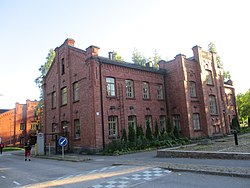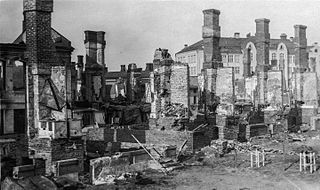
The Finnish Civil War was a civil war in Finland in 1918 fought for the leadership and control of the country between White Finland and the Finnish Socialist Workers' Republic during the country's transition from a grand duchy of the Russian Empire to an independent state. The clashes took place in the context of the national, political, and social turmoil caused by World War I in Europe. The war was fought between the Red Guards, led by a section of the Social Democratic Party, and the White Guards, conducted by the senate and those who opposed socialism with assistance late in the war by the German Imperial Army at the request of the Finnish civil government. The paramilitary Red Guards, which were composed of industrial and agrarian workers, controlled the cities and industrial centers of southern Finland. The paramilitary White Guards, which consisted of land owners and those in the middle and upper classes, controlled rural central and northern Finland, and were led by General C. G. E. Mannerheim.

Lahti is a city and municipality in Finland. It is the capital of the region of Päijänne Tavastia (Päijät-Häme) and its growing region is one of the main economic hubs of Finland. Lahti is situated on a bay at the southern end of lake Vesijärvi about 100 kilometres (60 mi) north-east of the capital city Helsinki, 38 kilometres (24 mi) south-west of Heinola and 74 kilometres (46 mi) east of Hämeenlinna, the capital of the region of Tavastia Proper (Kanta-Häme). It is also situated at the intersection of Highway 4 and Highway 12, which are the most significant main roads of Lahti.
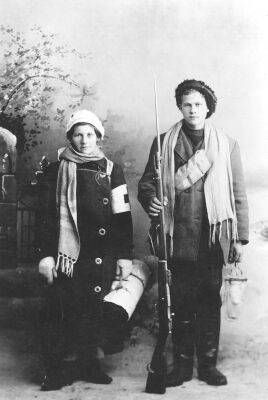
The Red Guards were the paramilitary units of the labour movement in Finland during the early 1900s. The Red Guards formed the army of Red Finland and were one of the main belligerents of the Finnish Civil War in 1918.
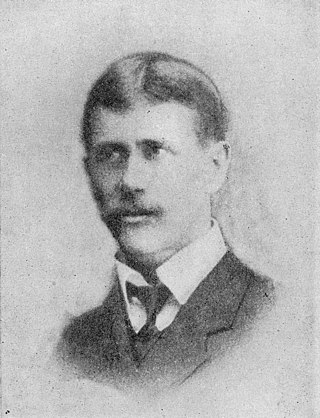
Frans Johan ”Janne” Myyryläinen was a Finnish Red Guard during the Finnish civil war. He was also a Red Guardian in Kainuu and an officer Guardian in Soviet Russia.

Hans Kalm was an Estonian soldier who served in the armies of Russian Empire, Finland and Estonia. He was also a homeopath and naturopath who took an interest in alternative medicine.

The Battle of Helsinki was a 1918 Finnish Civil War battle, fought in 12–13 April between the German troops and Finnish Whites against the Finnish Reds in Helsinki, Finland. Together with the battles of Tampere and Vyborg, it was one of the three major urban battles of the Finnish Civil War. The Germans invaded Helsinki despite the opposition of Finnish White Army leader Carl Gustaf Emil Mannerheim who wanted to attack the capital city with his own troops after Tampere had fallen on 6 April. However, the Germans had their own interest in taking Helsinki as quickly as possible and then moving further east towards the Russian border. The city had been under Red control for 11 weeks since the beginning of the war.
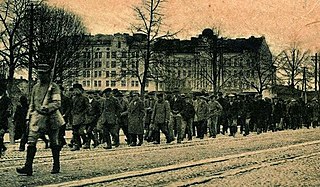
The Battle of Viipuri was a 1918 Finnish Civil War battle, fought 24–29 April between the Finnish Whites against the Finnish Reds in Viipuri. Together with the Battle of Tampere and Battle of Helsinki, it was one of the three major urban battles of the Finnish Civil War. The battle is also remembered because of its bloody aftermath, as the Whites executed up to 400 non-aligned military personnel and civilians of Russian and associated ethnicities.
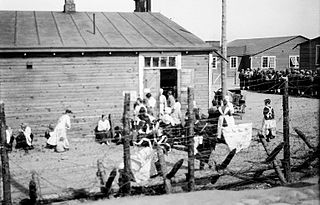
Tampere camp was a concentration camp operating from 6 April 1918 to 15 September 1918 in the Kaleva district of Tampere, Finland. It was set up for the Reds captured by the White Army after the Finnish Civil War Battle of Tampere.

Battle of Lahti was a 1918 Finnish Civil War battle, fought from 19 April to 1 May between the German troops and Finnish Whites against the Finnish Reds in Lahti, Finland. Together with the Battle of Viipuri, from 24 to 29 April, it was the last major battle of the war.

The Invasion of Åland was a 1918 military campaign of World War I in Åland, Finland. The islands, still hosting Soviet Russian troops, were first invaded by Sweden in late February and then by the German Empire in early March. The conflict was also related to the Finnish Civil War including minor fighting between the Finnish Whites and the Finnish Reds.

All-female units of the paramilitary Red Guards served in the 1918 Finnish Civil War. The first Women's Guards units formed in early February in the main Finnish cities. More than 15 female Guards units were established by the end of March 1918, with a total of about 2,000 women serving. The female Guards units consisted of young industrial workers, maids, and servants. Their average age was about 20, but some were as young as 14. The women served in auxiliary units in combat.
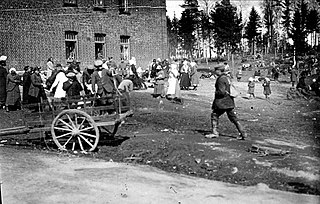
Hennala camp was a concentration camp operating from the beginning of May 1918 to 15 September 1918 in the Hennala Garrison in Lahti, Finland. It was set up for the Reds captured by the White Army after the Finnish Civil War Battle of Lahti.
The Harmoinen sick room mass murder was a significant incident in the Harmoinen village of the Kuhmoinen Parish that took place on 10 March 1918, during the Finnish Civil War, which according to the Reds met the criteria for a massacre. It took place during the Battle of Kuhmoinen, when the Whites executed 11 Red Guard patients and two male sanitaries. The Whites belonged to the 1st company and its battalion commanded by the Estonian born Hans Kalm. Kalm was not part of the incident and did not know anything about it, as he was engaged in the defense of the Kuhmoinen parish center at the time, against the Red Guards offensive in the direction of Jämsä. These claims are based on the stories by two survivors, reports by the Whites and other materials. Researcher of political history Jaakko Paavolainen thinks that "it is possible that shots were fired from the sick room, as the Whites have reported, but the claim that the snipers would have retired to the beds inside, is a rather fantastic one." There isn´t any clear evidence for the crime against any soldier of Kalm Battalion.

Keski-Lahti is the 1st district of the city of Lahti, in the region of Päijät-Häme, Finland. It covers the downtown areas of the city, circling the Market Square. It borders the districts of Niemi in the north, Kiveriö in the northeast, Paavola and Möysä in the east, Asemantausta in the south, Hennala and Sopenkorpi in the west and Kartano in the northwest.
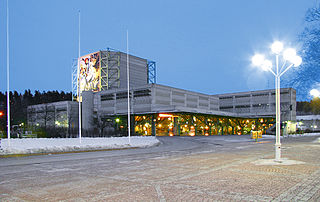
Paavola is the 3rd district of the city of Lahti, in the region of Päijät-Häme, Finland. It borders the districts of Kiveriö in the north, Möysä in the east and Keski-Lahti in the west.

Möysä is the 16th district of the city of Lahti, in the region of Päijät-Häme, Finland.
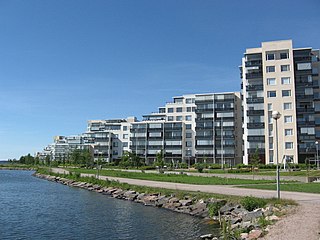
Niemi is the 4th district of the city of Lahti, in the region of Päijät-Häme, Finland. It borders the districts of Mukkula in the north, Kivimaa in the east, Kiveriö in the southeast and Keski-Lahti and Kartano in the south, as well as lake Vesijärvi in the west.
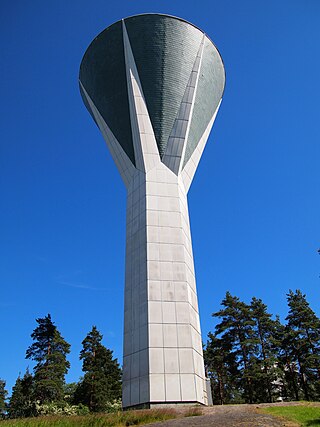
Kiveriö is the 5th district of the city of Lahti, in the region of Päijät-Häme, Finland. It borders the districts of Kivimaa in the north, Kytölä in the northeast, Myllypohja in the east, Möysä and Paavola in the south and Keski-Lahti, Kartano and Niemi in the west.
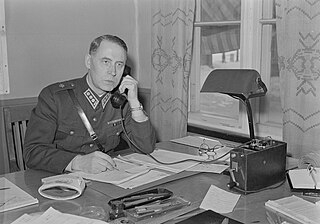
Mauno Viktor Vannas was a Finnish doctor, University of Helsinki permanent ophthalmology professor and inventor of Vannas' scissors.
Kustaa Albert Raitanen was a Finnish politician, born in Hinnerjoki. He was a member of the Parliament of Finland from 1916 until 1918, representing the Social Democratic Party of Finland (SDP). During the Finnish Civil War, he worked in the administration of the Finnish Socialist Workers' Republic. In April 1918, as the Red troops were retreating from Western Finland, Raitanen fled to Lahti, but disappeared shortly thereafter. He was seen in the city during the Battle of Lahti and according to some accounts, he died in the Hennala camp, but his body was never identified. He was declared legally dead in 1938.
